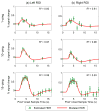Modeling hemodynamic responses in auditory cortex at 1.5 T using variable duration imaging acoustic noise
- PMID: 19948232
- PMCID: PMC2818577
- DOI: 10.1016/j.neuroimage.2009.11.051
Modeling hemodynamic responses in auditory cortex at 1.5 T using variable duration imaging acoustic noise
Abstract
A confound for functional magnetic resonance imaging (fMRI), especially for auditory studies, is the presence of imaging acoustic noise generated mainly as a byproduct of rapid gradient switching during volume acquisition and, to a lesser extent, the radiofrequency transmit. This work utilized a novel pulse sequence to present actual imaging acoustic noise for characterization of the induced hemodynamic responses and assessment of linearity in the primary auditory cortex with respect to noise duration. Results show that responses to brief duration (46 ms) imaging acoustic noise is highly nonlinear while responses to longer duration (>1 s) imaging acoustic noise becomes approximately linear, with the right primary auditory cortex exhibiting a higher degree of nonlinearity than the left for the investigated noise durations. This study also assessed the spatial extent of activation induced by imaging acoustic noise, showing that the use of modeled responses (specific to imaging acoustic noise) as the reference waveform revealed additional activations in the auditory cortex not observed with a canonical gamma variate reference waveform, suggesting an improvement in detection sensitivity for imaging acoustic noise-induced activity. Longer duration (1.5 s) imaging acoustic noise was observed to induce activity that expanded outwards from Heschl's gyrus to cover the superior temporal gyrus as well as parts of the middle temporal gyrus and insula, potentially affecting higher level acoustic processing.
Published by Elsevier Inc.
Figures








Similar articles
-
Temporal pattern of acoustic imaging noise asymmetrically modulates activation in the auditory cortex.Hear Res. 2016 Jan;331:57-68. doi: 10.1016/j.heares.2015.09.017. Epub 2015 Oct 28. Hear Res. 2016. PMID: 26519093 Free PMC article.
-
Influence of acoustic masking noise in fMRI of the auditory cortex during phonetic discrimination.J Magn Reson Imaging. 1999 Jan;9(1):19-25. doi: 10.1002/(sici)1522-2586(199901)9:1<19::aid-jmri3>3.0.co;2-k. J Magn Reson Imaging. 1999. PMID: 10030646
-
Nonlinearity of FMRI responses in human auditory cortex.Hum Brain Mapp. 2004 Jul;22(3):216-28. doi: 10.1002/hbm.20029. Hum Brain Mapp. 2004. PMID: 15195288 Free PMC article.
-
Spatial dissociation of changes of level and signal-to-noise ratio in auditory cortex for tones in noise.Neuroimage. 2008 Nov 1;43(2):321-8. doi: 10.1016/j.neuroimage.2008.07.046. Epub 2008 Aug 3. Neuroimage. 2008. PMID: 18722535
-
Stimulus-dependent activations and attention-related modulations in the auditory cortex: a meta-analysis of fMRI studies.Hear Res. 2014 Jan;307:29-41. doi: 10.1016/j.heares.2013.08.001. Epub 2013 Aug 11. Hear Res. 2014. PMID: 23938208 Review.
Cited by
-
Optimized design and analysis of sparse-sampling FMRI experiments.Front Neurosci. 2013 Apr 18;7:55. doi: 10.3389/fnins.2013.00055. eCollection 2013. Front Neurosci. 2013. PMID: 23616742 Free PMC article.
-
Auditory Target Detection Enhances Visual Processing and Hippocampal Functional Connectivity.Front Psychol. 2022 Jun 13;13:891682. doi: 10.3389/fpsyg.2022.891682. eCollection 2022. Front Psychol. 2022. PMID: 35769754 Free PMC article.
-
Temporal pattern of acoustic imaging noise asymmetrically modulates activation in the auditory cortex.Hear Res. 2016 Jan;331:57-68. doi: 10.1016/j.heares.2015.09.017. Epub 2015 Oct 28. Hear Res. 2016. PMID: 26519093 Free PMC article.
-
Assessment of temporal state-dependent interactions between auditory fMRI responses to desired and undesired acoustic sources.Hear Res. 2011 Jul;277(1-2):67-77. doi: 10.1016/j.heares.2011.03.008. Epub 2011 Mar 21. Hear Res. 2011. PMID: 21426929 Free PMC article.
-
Frequency Selectivity of Voxel-by-Voxel Functional Connectivity in Human Auditory Cortex.Cereb Cortex. 2016 Jan;26(1):211-24. doi: 10.1093/cercor/bhu193. Epub 2014 Sep 2. Cereb Cortex. 2016. PMID: 25183885 Free PMC article.
References
-
- Bamiou DE, Musiek FE, Luxon LM. The insula (Island of Reil) and its role in auditory processing. Literature review. Brain Res Brain Res Rev. 2003;42:143–54. - PubMed
-
- Bandettini PA, Jesmanowicz A, Van Kylen J, Birn RM, Hyde JS. Functional MRI of brain activation induced by scanner acoustic noise. Magn Reson Med. 1998;39:410–416. - PubMed
-
- Barrett DJK, Hall DA. Response preferences for “what” and “where” in human non-primary auditory cortex. NeuroImage. 2007;32:968–977. - PubMed
-
- Calhoun VD, Stevens MC, Pearlson GD, Kiehl KA. fMRI analysis with the general linear model; removal of latency-induced amplitude bias by incorporation of hemodynamic derivatives terms. NeuroImage. 2004;22:252–257. - PubMed
Publication types
MeSH terms
Grants and funding
LinkOut - more resources
Full Text Sources
Other Literature Sources
Medical

